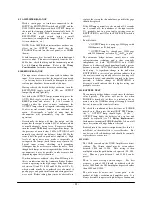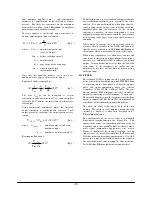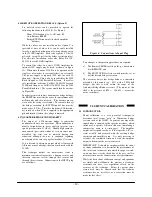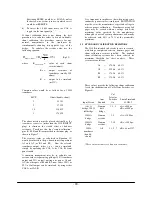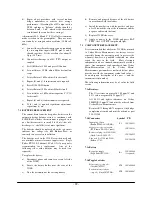
- 22 -
d)
Repeat above procedure with several random
bridge unbalances to achieve best average
performance. (If reading the ±10V output with a
DVM, readings at “balance” ideally should be
between 0 and –3 mV, which is the theoretical
resolution of the circuit at these settings.)
Adjustments H, L, M and Y (C31) all affect common-
mode rejection in the preamplifier. They are most
conveniently set using an audio oscillator (10 Hz to 5
kHz):
a)
Connect the oscillator between circuit ground and
the two amplifier inputs (INPUT pins A and J)
shorted together. Set the oscillator for about 10
Vp-p (3.5 Vrms).
b)
Connect oscilloscope to ±10V (TP7) output, ac-
coupled.
c)
Set GAIN dial at 1.000 and press X1 button.
d)
Set oscillator at 10 Hz; adjust M for best null on
scope.
e)
Set oscillator at 1 kHz; adjust L for best null.
f)
Repeat (d) and (e) if adjustments were required.
g)
Press X100 GAIN button.
h)
Set oscillator at 10 Hz; adjust H for best null.
i)
Set oscillator at 1 kHz; adjust capacitor Y (C31)
for best null.
j)
Repeat (h) and (i) if adjustments were required.
k)
If (h) and (i) required significant adjustment,
repeat from (c) on.
7.2
BATTERY REPLACEMENT
The current drain from the keep-alive batteries in the
automatic bridge balance circuit is continuous with
POWER off, whether the instrument is plugged in or
not, but this current is so small 5 to 10 nA) that self-
discharge (i.e., shelf-life) is far more significant.
The batteries should be replaced when the test circuit
indicates low voltage (see
4.11 Battery Test
), or
routinely two years after installation.
The batteries used in the 2310B are widely used and
are available at most electronic supply stores. Eagle
Picher PT-2150 (Lithium 3.6Volt, 1/2AA) or equal is
recommended for a replacement. Any of the
following silver oxide batteries may be used (two
required):
To replace the battery:
a)
Disconnect power and remove cover on left side
of the 2310B.
b)
Locate the battery holder near the rear of the
2310B.
c)
Note the orientation of the existing battery.
d)
Remove and properly dispose of the old battery
in accordance with local codes.
e)
Install the new battery with the positive end (case
of cell) toward the rear of the instrument, and the
negative end toward the front.
f)
Replace 2310B side cover.
g)
Apply ac power to the 2310B and press BAT
TEST; the + OUTPUT lamp should light.
7.3
COMPONENT REPLACEMENT
It is recommended that a defective 2310B be returned
to Vishay Micro-Measurements for factory service,
especially during the warranty period (to preserve the
warranty); however, a qualified technician can often
repair the unit in the field. Most electronic
components used are standard commercially available
items. Any component can be purchased from Vishay
Micro-Measurements
(if
the
Vishay
Micro-
Measurements part number is not listed below, please
provide us with the component symbol and value —
or an adequate description of the part — and the
instrument serial number).
The following information may be of value for field
service.
7.3a Resistors:
The 1% resistors are generally 100 ppm/°C, and
0.1% values are generally 25 ppm/°C).
All 0.05% and tighter tolerances are Vishay
SMR1DR (2 ppm/°C) and must be ordered from
Vishay Micro-Measurements.
Resistors R71 through R74 are part of the bridge
completion assembly and must be ordered as part
200-131240.
7.3b Connectors
Symbol P/N
Input plug, 15-pin
[Bendix PT06A-14-15P(SR)]
P5
12X300531
Mating power plug (not supplied)
(ITT/Cannon DA15S or equal)
—
12X300151
Remote cal plug (for 2350/2360)
(Cinch-Jones S-308-CCT)
—
12X300533
Line cord (for 2350 and 2360)
(Belden 17742)
—
21X300126
7.3c Battery
Keep-alive supply
(Eagle Picher PT-2150)
B1
23X500004
(1 required)
7.3d Toggle Switches
Filter selector (on p.c.b.)
(Grayhill 76TC03)
SW1
10X900046
Excitation sense selector
(on p.c.b.) (Grayhill 76TD01)
SW5
10X900047




